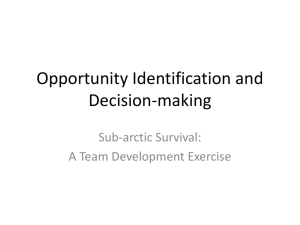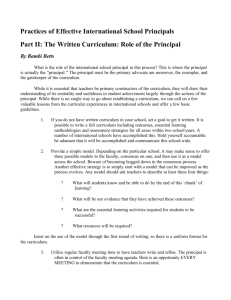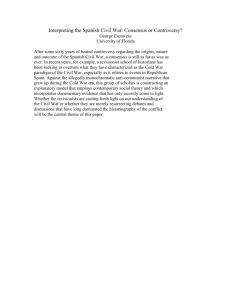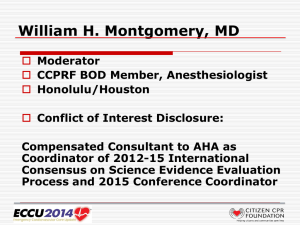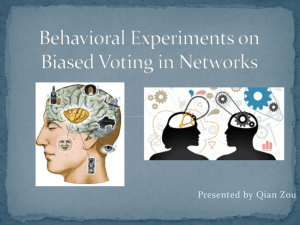Change Management
advertisement
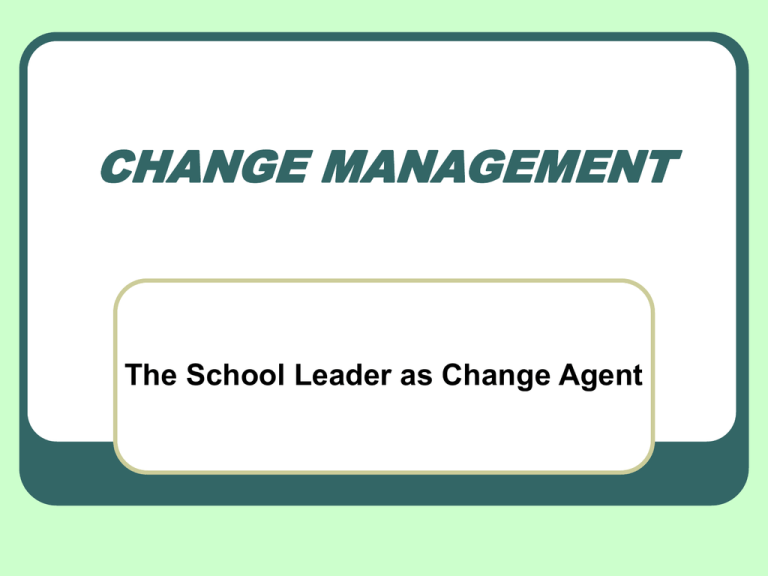
CHANGE MANAGEMENT The School Leader as Change Agent Why Change? MOST SCHOOLS HAVE BEEN DESIGNED TO SOLVE YESTERDAY’S PROBLEMS, RATHER THAN CAPITALIZING ON TODAY’S OPPORTUNITIES TO EFFECTIVELY CONFRONT THE ISSUES OF TOMORROW THAT WHICH GOT US WHERE WE ARE IS NOT VERY LIKELY TO GET US WHERE WE WANT TO GO! PEOPLE USUALLY SUPPORT IMPROVEMENT --IT’S CHANGE THEY DON’T LIKE! “THERE IS NOTHING PERMANENT EXCEPT CHANGE” Barriers to Change Why do people resist change? The status quo provides a certain comfort zone Need for stability Need for predictability Fear of the unknown Others??? Model of Employee Decision to Actively Resist an Organizational Change Effort Tools to Facilitate Change Managing Complex Change • Force Field Analysis • Consensus Building • Management of Complex Change: Critical Components Vision –Strategic Planning Skills Incentives Resources Action Plan Management of COMPLEX CHANGE VISION VISION VISION + SKILLS + SKILLS + + SKILLS + INCENTIVES + ACTION PLAN =CHANGE + RESOURCES + ACTION PLAN =CONFUSION + RESOURCES + ACTION PLAN =ANXIETY + RESOURCES ACTION PLAN =GRADUAL + RESOURCES + INCENTIVES + INCENTIVES + + CHANGE VISION + SKILLS + INCENTIVES + + ACTION PLAN =FRUSTRA- TION VISION + SKILLS + INCENTIVES + RESOURCES =FALSE STARTS Management of Complex Change Activity With a person sitting next to you, go through the complex change matrix with this situation: You are asking every staff member to incorporate cooperative learning strategies into their lessons. Decide what must be done to make sure each component of the matrix has been addressed. Force Field Analysis: Critical Components Desired Change Driving Forces –Favoring Change Restraining Forces –Resisting Change Equilibrium or Current Status FORCE FIELD ANALYSIS State Desired Change Here DRIVING FORCES Forces favoring the change RESTRAINING FORCES Forces resisting the change (EQUILIBRIUM OR CURRENT STATUS) Force Field Analysis Activity With a person sitting next to you, work with the force field analysis using this situation: You have decided to ask staff to help you increase parent involvement at your school. What are the driving and restraining forces involved? How can you increase the driving forces and decrease the restraining forces? How Can Leaders Best Support the Improvement Effort? (From McREL, 2000) I. Recognize the Differences Between Leadership & Management II. Give Up the Notion of the “Hero-Leader” III. Develop Broad-Based Leadership IV. Encourage Individual Initiative V. Develop a Learning Organization VI. Take a Balcony View Effective School Leaders Must: Increase their own knowledge base Take risks, break new ground, and cultivate a climate of experimentation Share leadership with competent staff -put less competent staff “on a short leash” Help others to acquire reform-related knowledge and skills Be persistent Appreciate incremental change (baby steps) Overlapping Arenas of Management Expertise Needed for Change to Take Root & Thrive Management of day to day school issues Management of long term school issues Maintenance of relationships with the governing body Maintenance of relationships with the community Conclusions from a Body of Recent Research: Effective school leaders are those who are visionary and skillful learners, as well as strong and competent partners in facilitating and sustaining reform Conclusion: One can become a notably successful school leader given any of a considerable array of gifts and tendencies. It’s what you do with what you have that really counts! How Do These Puzzle Pieces Fit Together to Make a Coherent Whole? Effective School-wide Leadership Requires Understanding of… The System- context in which you operate, including school/agency/district norms, local, state, and federal policies, and standards of accrediting bodies for public & private programs Yourself- leadership style, preferences for change, facilitation skills, philosophy of teaching and learning Others- those who serve as “levers” and those who must make changes Relational Leadership Model SYSTEM OTHERS SELF You as a Leader Your own orientation to change, leadership and management styles, and philosophy of teaching and learning provide the pathways for determining how you, as a unique individual, can be successful Relationship to Others Nearly all studies show that without buy-in from teachers, change is “doomed”. At the very least, you need a critical mass of support. Building Consensus: What Is Consensus? Group decision-making process Everyone's opinion is encouraged and valued Differences are viewed as helpful rather than hindering All voices are heard and understood before an effort to finalize a decision is made After full discussion, those who continue to disagree indicate willingness to experiment for a prescribed period of time All members share in final decision-making Advantages of Decision-Making by Consensus Can be informal or use formal procedures Members are more likely to support the decision Provides for a win-win solution Facilitates open communication Requires members to listen and understand all sides of the issue Sets the stage for action - who, what, where, when, how & why Disadvantages of Decision-Making by Consensus Trust is needed among members of group to encourage sharing Group leaders must use facilitation rather than control Takes more time to reach consensus, especially in larger groups 7 magic number for reaching group consensus One or two people tend to dominate larger groups Steps in Facilitating Consensus 1. Identify and define problem, situation, or issue 2. Brainstorm list of alternatives –suspend judgment; do not discuss or reject any ideas 3. Review, change, consolidate, rewrite and set priorities as a group through discussion 4. Make a decision and put in writing 5. Later, review and evaluate results; revise as needed Consensus Building: Activity As a group, come to consensus in regard to the following scenario: Everyone in the group is a teacher at the same school and each staff member must have 15 clock hours of professional development per year. All have personal preferences for the topics of upcoming professional development workshops. You must decide as a group what areas you want further training in and reach consensus on three topics. Summary To be effective as a change agent, consider and understand: • The system or context in which you work • Yourself as a leader • What it takes to motivate and involve others


